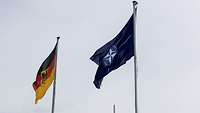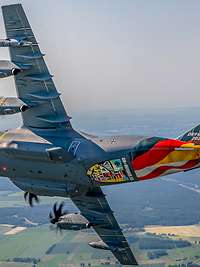The Western Alliance in the Fight against the Occasus Alliance
The Western Alliance in the Fight against the Occasus Alliance
- Date:
- Place:
- Germany
- Reading time:
- 3 MIN
Combat operations on German soil, scarce energy resources, and a population exhausted by corona and inflation: how to respond when an enemy military alliance occupies part of Germany? This is the geopolitical starting point for the Air Defender 23 exercise.
Germany, in a fictitious year of the future: NATONorth Atlantic Treaty Organization's years-long confrontation with the eastern military alliance OCCASUS has reached the soil of the Federal Republic. Special forces of the Brückner organization and other troops of OCCASUS could be smuggled into Germany from the east. Now air and ground forces hold the entire Klebius region, about a quarter of the country. And the next tactical move is already in sight: The OCCASUS alliance is trying to push north to the Baltic Sea and take possession of the port of Rostock. To do so, it is using a mix of sabotage operations and the use of special forces supported from the air. As a result, the Western alliance triggers a state of defense under Article 5 of the NATONorth Atlantic Treaty Organization treaty.
Stopping the advance into northern Germany
The conflict, which spans the line between the Arctic and the Black Sea, had been building up for some time. In the scenario, the state of Murinus and its allies Plumbeus, Griseus and Cinereus are linked by joint trade and security agreements. To weaken NATONorth Atlantic Treaty Organization, the eastern alliance first increased its military presence in the alliance area's neighborhood, such as near the Baltics. In a special operation, OCCASUS most recently attacked and swiftly captured the state of Otso outside NATONorth Atlantic Treaty Organization alliance territory.
With an eye on NATONorth Atlantic Treaty Organization countries such as Germany, where OCCASUS sympathizers influence public opinion, OCCASUS is leaving it at hybrid warfare for now. The shortage of energy supplies is hitting the German economy, still weakened by the Corona pandemic, particularly hard, especially as inflation rates are rising rapidly. But if the wheels mesh with the Western air forces, at least the further advance into northern Germany will be halted.
Test for the ability to react and act
So much for the scenario that provides the geopolitical backdrop to the situation during the major Air Defender exercise. From June 12 to 23, up to 10,000 exercise participants from 25 nations will train with 250 aircraft in various air operations. These are clearly the focus of the multinational exercise under the aegis of the German Air Force - even though the conflict in the imagined scenario is far more complex, also encompassing the political, economic and media levels. The core of the large-scale exercise is to test the military's ability to react and act in the air in a resilient manner and to be able to protect the population from medium-range missiles, for example. Exercises will mainly take place in three flight corridors over Germany, the North Sea and the Baltic Sea - including aerial refueling and low-level flights. Under the eastern exercise area is the fictitious region of Kleibus, which in the scenario is occupied by the OCCASUS alliance.
Background
Every exercise requires a fictitious scenario in order to train military operations realistically based on it. The fictitious geopolitical scenarios then serve as a basis for the operation planners to plan in detail the individual military exercise missions that are part of the overall exercise.




